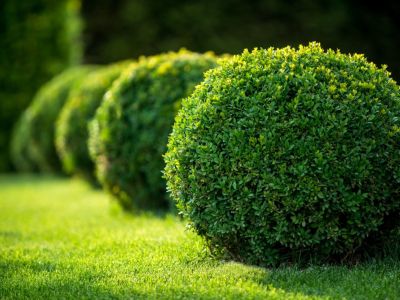Growing boxwood in your home landscape allows you to create a formal hedge, a matching border, or a pair of boxwood plants to balance an entryway. Boxwoods may also be planted as focal points or foundation plantings.
Tips for Planting Boxwood
When choosing where to plant boxwoods, make sure to plant them in the spot most appropriate for their needs. A full or part sun location is needed for optimum growth of this specimen. Successfully growing boxwood requires well-drained soil and while the plants prefer soil to be organic, the boxwood’s soil needs are adaptable. When planting boxwood, consider your year-round climate. If temperatures become extremely hot in summer, boxwood plants will appreciate afternoon shade and regular watering. Water deeply, as frequent, shallow irrigation will not reach the root zone of the growing boxwood. Until established, after about two years, boxwoods will need at least weekly watering. When planting boxwood, locate them in an area that is protected from winter wind to avoid a condition called winter bronzing. Plant at the same level they were planted at the nursery or in the container. Planting boxwood too deeply can lead to stress and possibly death.
Information on Boxwood Care
Properly mulching the shallow-rooted boxwood helps retain moisture and keep roots cool. Growing boxwoods should have a 2 to 3 inch (5-8 cm.) layer of mulch extending 12 inches (31 cm.) past the foliage. As with all shrub mulching, trunks should not be covered. Aside from watering and mulching, growing boxwood is a low maintenance task, unless you wish to keep them as a sheared hedge. Shearing, or pruning of boxwood, is the most time-consuming part of boxwood care when they are grown as a hedge, but you will be rewarded with a healthy, long-lasting hedge. Older boxwood care will include thinning limbs to allow sunshine to reach the inner foliage. The boxwood leaf miner is the most common pest one must deal with when caring for boxwoods. If foliage begins to yellow, treat with organic oil or insecticidal sprays. Phytophthora root rot may result from soggy soils. Yearly soil tests can determine if the soil pH for the boxwood is correct. Soil pH should be between 6.5 and 7. It is best to test the soil before planting boxwood. pH can be raised with the addition of lime and lowered by sulfur. As slow-growing landscape plants, boxwoods are valuable, and consequently they are expensive. Take time to choose where to plant boxwood carefully. Remember to water and mulch properly for a long-lived, vigorous specimen.
